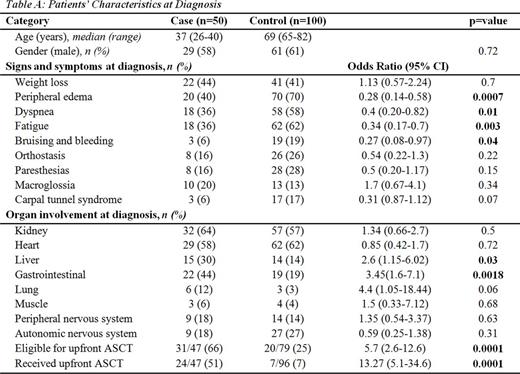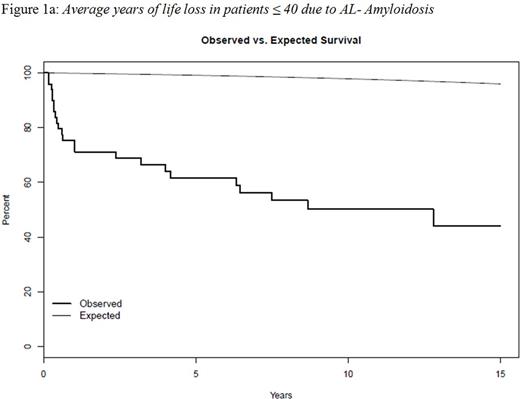Abstract
BACKGROUND
Light-chain amyloidosis (AL) is the most common form of systemic amyloidosis, with an incidence of approximately 1 case/100,000 person-years. Clinically relevant data with regard to the very young (≤ 40 years) patients (pts) are scant. We present a case-control study of very young pts with AL seen at a single institution.
METHODS
We reviewed the medical records of all pts with AL who were consecutively evaluated at Mayo Clinic, Rochester, MN between 01/01/1995 and 12/31/2015. The clinical characteristics and survival outcomes of very young pts at the time of AL diagnosis (cases) were compared to a 2:1 matched cohort of pts (controls) with AL who were 65 years or older and matched by the time of diagnosis. Upfront autologous stem cell transplantation (ASCT) was defined as transplantation within 6 months of the diagnosis of AL. The Kaplan-Meier method was used to all time-to-event analyses. The average years of life lost was computed by subtracting the mean survival from diagnosis observed in the cohort from the mean survival expected in the population based on life-tables.
RESULTS
Of 3433 pts with AL, 50 (1.5%) pts were ≤ 40 years of age at diagnosis (cases). Fatigue, peripheral edema, dyspnea and bleeding were less common at presentation in cases compared to controls (table A). The cases were also more likely to have liver or GI involvement (OR= 3.45, 95% CI: 1.6-7.2). Unusual initial clinical features in the cases included unprovoked splenic rupture (2%) and erectile dysfunction (4%) observed 6-15 months prior to the diagnosis of AL in cases; no such features were observed in the control group. The median time between the onset of symptoms and definitive diagnosis was 0.4 years (95% CI: 0.3-0.7) for the cases and 1 year (95% CI: 0.8-1.2) for controls (p<0.0001). The ECOG performance score at diagnosis was ≥2 in 51% of cases compared to 78% of the controls (OR= 0.29, 95% CI: 0.14-0.63). The involvement by 3 or more organs at diagnosis was comparable [24 (48%) cases compared to 34 (34%) controls (p=0.11)]. Concomitant myelomatous (AL-CRAB) features were evident in 12% of each group and 27 (54%) cases and 37 (41%) controls had >10% BMPCs without active myeloma (AL-PCMM) (p=0.16). Monoclonal light chain involvement without involvement of heavy chain was seen in 23 cases (50%) and 31 controls (32%), (OR= 2.1, 95% CI: 1.04-4.37).
The median follow-up was similar for cases and controls, [10.9 years (95% CI: 7.6-12) vs 9.9 years (95% CI 8-14)], respectively. The estimated average years-of-life lost was 8.6 years over 20 years of follow-up in cases, (Figure 1a). In cases, 1 and 10-year overall survival (OS) from diagnosis was 73% and 51%, respectively (median OS 12.7 years; 95% CI: 4.0-NR) while, in controls, 1 year and 10 year OS was 62% and 15% respectively (median OS 2.1 years; 95% CI (1.0-3.6), p<0.001), (Figure 1b). Cardiac involvement was associated with a worse OS in both cohorts, (cases: median OS was 3.2 years with cardiac involvement (95% CI: 0.6-8.7) vs NR (95% CI: 8.0-NR) in those without; p=0.003; controls: median OS was 1.1 years with cardiac involvement (95% CI: 0.53-1.6) vs 4.8 years (95% CI: 3.7-8.1) in those without; p=0.02.
Thirty one of 47 (66%) cases were eligible and 20 of 79 (25%) controls were eligible for upfront ASCT. In cases, upfront ASCT was associated with a longer OS. Median OS was NR (95% CI: NR-NR) in pts who underwent upfront ASCT (n=25) vs 4.0 years (95% CI: 0.5-8) in pts who did not, p≤0.0001. For controls, the median OS was 9 years (95% CI: 0.5-11) for pts who underwent upfront ASCT (n=7) vs 1.6 years (95% CI: 1.0-2.8) for pts who did not (n=93), p=0.26. In cases, six (12%) pts underwent solid organ transplantation (kidney 5, heart 1) and none in the control arm.
CONCLUSIONS
AL amyloidosis is infrequently encountered at the age of ≤40 years, but the loss of productive years of life and the disease burden are substantial in this cohort. A substantial delay in diagnosis from the onset of symptoms was noted in our study in the control population. Cardiac involvement remains a primary determinant of prognosis irrespective to age. Although over one-half of young pts are alive 10 years after the diagnosis (contrast ≈15% ≥ 65 years), early mortality remains substantial irrespective of age. An ASCT-based approach is associated with superior outcome in the young. A greater proportion of the young pts is fitter and ASCT-eligible at diagnosis, and should therefore be offered this approach.
Dispenzieri:Jannsen: Research Funding; Takeda: Membership on an entity's Board of Directors or advisory committees, Research Funding; GSK: Membership on an entity's Board of Directors or advisory committees; Celgene: Research Funding; pfizer: Research Funding; Prothena: Membership on an entity's Board of Directors or advisory committees; Alnylam: Research Funding. Kumar:Array BioPharma: Consultancy, Research Funding; Kesios: Consultancy; Onyx: Consultancy, Research Funding; Noxxon Pharma: Consultancy, Research Funding; AbbVie: Research Funding; Glycomimetics: Consultancy; Janssen: Consultancy, Research Funding; Celgene: Consultancy, Research Funding; Sanofi: Consultancy, Research Funding; Millennium: Consultancy, Research Funding; BMS: Consultancy; Skyline: Honoraria, Membership on an entity's Board of Directors or advisory committees. Kapoor:Amgen: Research Funding; Takeda: Research Funding; Celgene: Research Funding.
Author notes
Asterisk with author names denotes non-ASH members.




This feature is available to Subscribers Only
Sign In or Create an Account Close Modal